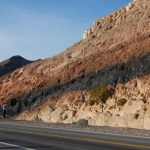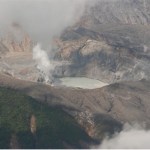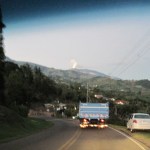Costa Rica
So, I'm a little late with this thanks to a little hiatus, but I thought I would post the latest GVP Weekly Volcanic Activity Report. Thanks again to the Smithsonian, USGS and especially Sally Kuhn Sennert!
Some highlights include:
There were more ash explosions spotted at Ebeko in Kamchatka, producing ~1.8 km (5,900 foot) ash columns. This activity prompted KVERT to raise the Alert Status to Yellow. This goes along with news from a pile of other Kamchatka/Kuril Island volcanoes: Gorely, Tiatia, Karymsky, Kliuchevskoi and Shiveluch.
More activity at Arenal in Costa Rica - its almost always…
For all of you going into withdrawal now that Eyjafjallajökull seems to have quieted down, there are two eruptions of note that aren't in the North Atlantic:
Undated image of the Barujari cone at Mt. Rinjani in Indonesia.
Arenal in Costa Rica - which is almost always sputtering away - had a more significant explosive and effusive event today. The volcano produced enough ash, bombs and gas emissions - along with 8 lava flows (or avalanches, depending on the source) - to prompt the evacuation of the National Park around the volcano. Arenal has had numerous strombolian eruptions over the last…
The latest Weekly Volcanic Activity Report from our friends at the Smithsonian Global Volcanism Program and the USGS.
Highlights (not including Eyjafjallajökull - you can check the latest IMO update on that eruption and the latest VAAC ash advisories.):
Villarrica in Chile was raised from Alert Level 1 to 2 by the Chilean SERNAGEOMIN after an increase in seismicity, a rise in the lava lake levels at the summit and more vigorous fumarolic activity.
In the first update in a while, a small ash plume was noticed at Chaiten in Chile, rising to ~1.8 km (8,000 feet) from the new domes.
Karymsky in…
Gaua erupting in February 2010. Image courtesy of the NASA Earth Observatory.
As a certain famous Icelandic native would say, "there is more to life than this."
Some other volcano news from around the world:
The situation at Gaua in Vanuatu is worsening. Ash from the current eruption is contaminating water and food supplies on the island. Authorities are planning on evacuating 3,000 people from the island if the eruption that started in 2009 gets worse, but there has already been significant ash fall, mudflows and explosions.
Shiveluch on the Kamchatka Peninsula in eastern Russia continues…
I'm still playing catch-up after my week in the desert, so I've seen a lot of articles I've wanted to mention ... but a certain other volcano has taken up a lot of my time. However, I will attempt to make amends for that now.
By the way, would you believe Ubehebe Crater was closed? How do they close a volcano, anyway? However, I did get a great snap of a welded tuff on the road outside of Shoshone, CA.
A strongly welded tuff near Shoshone, CA. The dark interior is remelted volcanic ash/tephra surrounded by less welded pink tuff with abundant pumice clasts. Denison student David Sisak is on…
Leaving for Death Valley tomorrow - I'll be sure to take some pictures of Ubehebe Crater and the volcano at the Mirage. This will likely be the last new post until about a week from now, but look for the Erta'Ale Volcano Profile, maybe a new Mystery Volcano Photo and I'll leave a thread open for any new volcano news.
Colima in Mexico.
Eruptions reader Tim Stone sent me this image from Japanese astronaut Soichi Noguchi's Twitpic feed - it is a stunner of the caldera on Jebel Marra in Sudan. The only known historical eruption for this volcano was ~2000 BC within the Deriba Caldera, but it has…
Some news for a busy Tuesday:
The crater at Poas volcano in Costa Rica, taken February 25, 2010. Image courtesy of OVSICORI by Federico Chavarria.
After the MSNBC debacle, it is nice to see some good articles on why the Chilean earthquake was overall less disastrous than the Haitian earthquake, why the tsunami wasn't as large as predicted and why these earthquakes are not abnormal. There are a lot of factors involved - the location, depth, preparedness, wealth - so the comparison can be very telling in terms of both geologic and societal issues.
The other scientific fallout from the Chilean…
Two quick notes:
A Costa Rican farmer evacuating in early January 2010 after renewed activity of Volcan Turrialba.
Well, it appears that after a quiet night on Friday, the current Yellowstone swarm picked up where it left off. We're now up to 1,200 earthquakes since January 17th, with a pair over M3 today. Of course, people are still uppity about the swarm, especially after the earthquake in Haiti, but really, they're about as connected as worrying about the rainy day in Boston when there was a typhoon in Malaysia. Just to get people on the same page, YVO still says: "The swarm events are…
This week's USGS/Smithsonian GVP Volcano Update!
Highlights include:
A volcano I had never heard of in the Kuril islands is showing signs of life: Kharimkotan. Satellite images show a thermal anomaly at the summit of the volcano - its last known eruption was in 1933.
Ash, sulfur dioxide and steam continue to erupt from Nyamuragira in the Congo, although lava flows have abated.
Crater C at Arenal had sporadic strombolian activity - which is par for the course for the Costa Rican volcano.
I must have missed this, but since December 14, the ash erupted at Gaua in Vanuatu has become denser and…
Somehow I haven't posted a bunch of interesting items collected over the last few weeks, so I need to catch up. A pre-emptive hat tip to everyone who has sent me links or notes that might seem familiar in this post.
Tungurahua in Ecuador erupting in 2000.
First off, those of you looking for information on the Haitian earthquake that devastated the capitol Port Au Prince, Highly Allochthonous has post on the tectonics of the quake. Right now, it is hard for me to come up with a worse location in terms of devastation for a quake to have hit in the Caribbean Basin.
Back in volcano news, a lot…
The streaming crater of Turrialba in an image taken in mid January 2010.
I have a moment to spare here at WMU, so I thought I would pass some of this confusing news along concerning Turrialba. Some of the latest reports refer to a "crack" in the crater of the volcano ... specifically:
Geologists and volcanologists were at least able to confirm that the crack on the wall of the volcano is getting larger, confirmed by flybys by helicopters during a break in the weather. The experts say the constant spewing of gases is causing the crack to get bigger and could collapse the volcano's crater wall…
The weekend! No updates until next Tuesday - I'll be off to give a talk at Western Michigan University.
Coal-erupting volcanoes defeat the Permian dinosaurs ... according to FOX News.
Anyway...
You know that mainstream media (FOXNews) must have done something appalling when even I can't write about it thanks to my seething rage. I'll let Chris Rowan at Highly Allochthonous and Ralph at the Volcanism Blog sum up how FOX News tried to explain the extinction of the dinosaurs (hint 1: it happened before dinosaurs even existed. hint 2: volcanoes erupt coal now).
After you've read about that…
The steam plume from Turrialba on December 26, 2009. Image by Eruptions reader Sahrye Cohen.
Turrialba
Costa Rican officials extended the evacuation zone around Turrialba from 3 to 6 km, raising the alert status at the volcano to Yellow. Vanessa Rosales of the National Emergency Commission described the seismicity as "intense but low," but says the country is prepared to deal with the emergency. As always, the news chooses oddly what is the "news" of an event, and many article on Turrialba focus on Costa Rica's coffee - yes, it is safe, so far. A news report from the Tico Times quotes Raul…
Two volcanoes down, two volcanoes up!
Fire fountain on Nyamuragira in the Congo, January 2010.
Down
Mayon
Activity at Mayon has continues to drop - although PHIVOLCS warns that an eruption could happen at any moment and without much warning. About a quarter of the evacuated families have no returned home since PHIVOLCS gave the OK to return home on January 2 - but Philippine officials are still on alert in case evacuations have to be reinstated.
Redoubt
The resurgent Redoubt is no long ... er ... resurging? AVO lowered the alert status to Green - meaning normal/background levels of activity…
Yet another new eruption for 2010!
Turrialba volcano in Costa Rica in an undated photo.
Turrialba in Costa Rica erupted today, prompting the evacuation of tens of people from the region near the volcano. The eruption appears to be relatively small, producing ash and some pyroclastic material. The area around the volcano is not very populated and isn't near the profitable coffee-growing region of Costa Rica. This eruption is the first at Turrialba since 1866, over 130 years ago. That eruption was a VEI 3, so Turrialba is definitely a volcano to watch if the activity continues.
Also in Costa…
The latest news from the USGS/Smithsonian Global Volcanism Program Weekly Volcano Report ...
Highlights (not including Mayon) include:
Strombolian eruptions and small pyroclastic falls at Arenal in Costa Rica.
3 km / 10 000 foot ash plume from Bagana on Bougainville Island in Papua New Guinea.
Rumbling noises, ~4.5 km / 14 000 foot ash plumes and incandescence were all reported coming from Fuego in Guatemala.
Steam-and-ash from Popocatepetl near Mexico City reached 7.4 km / 24 300 feet.
Satellite images of Shiveluch revealed a large thermal anomaly - the new lava dome - along with multiple…
So, the field still stands unblemished, having identified all 8 MVPs, usually within less than 7 tries. Nice job!
Current MVP Standings:
volcanista - 1
Elizabeth - 1
Ralph - 1
gijs - 1
Anne - 1
Cam - 1
gg - 1
The Bobs - 1
MVP #7 was Arenal in Costa Rica. It was initially going to be Rincon de la Vieja, but somehow I mixed up the pictures. I think a lot of you know a lot more about Arenal than I do, but it is one of the most active - and easily visited - volcanoes in the Western Hemisphere.
Eyjafjöll volcanoHekla from the northwest in Iceland, not your MVP #8.
MVP #8 was Eyjafjöll (or…
Some brief notes before I dive headlong into the exciting world of faculty orientation!
A small steam plume coming from Turrialba in Costa Rica. Photo taken in August 2007.
There are some preliminary reports of the state of wildlife (and everything) around Kasatochi Island in the Aleutians from the US F&W and USGS team that headed to check out how the island has recovered since last year's eruption. The shoreline has been radically transformed by the ash and although some seabirds have made attempts to nest in the loose ash, it doesn't seem to have been very successful. However, not…
The Q&A post will be coming over the weekend (there's still time to send me a question!)
Icy cold volcanoes (well, geysers) on Enceladus, a moon of Saturn.
In the meantime, here are a few quick hits:
Mt. Cleveland in the Aleutians had a small eruption. The plume was only ~15,000 feet / ~3 km. Cleveland is one of the more active volcanoes in the Aleutians, so this eruption is not out of the norm.
Landslides and rockfalls at Arenal (in spanish) in Costa Rica continue to prompt evacuations of tourists near the volcano. It is interesting to note that officials don't seem worried about hotel…
Arenal in Costa Rica, erupting in July 2007. Image courtesy of Arenal.net.
Arenal in Costa Rica is one of the most active volcanoes in Central America. It is almost one of the most picturesque (see above) and, dare I say, touristy, volcanoes in the world. However, even volcanoes that seem "benign" like Arenal require special precautions.
Yesterday Arenal has two small eruptions that were accompanied by unusual tremors, (in spanish) according to Javier Pacheco of the Volcanological and Seismological Observatory of Costa Rica (OVSICORI). The tremor started at 7 AM and continued until 4:30 PM,…


